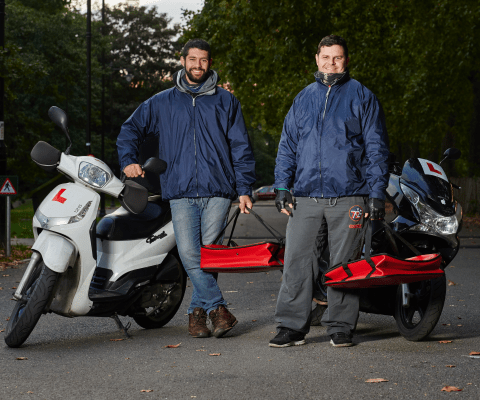No sooner did I out Valk Fleet, Delivery Hero’s new B2B startup that lets take-outs and restaurants outsource delivery, than another London competitor lands on my radar.
Delivery Cube, which is currently operational in part of South London and launched before Valk Fleet, pitches itself as a “B2B technology driven logistics solution”. Like Delivery Hero’s stealthily launched company, the startup combines its own in-house tech with a fleet of drivers to enable restaurants and take-outs to offer delivery without employing their own drivers and regardless of which channels food orders come from.
This can be via consumer-facing online take-out ordering aggregators, such as Just Eat or Delivery Hero (Hungryhouse in the U.K.), directly from a restaurant’s own website/via telephone, or through Deliveroo and its ilk, which are also consumer-facing and are primarily targeting premium restaurants who don’t traditionally offer take-out but want to get in on the food for delivery action.
Most noteworthy, however, is that two of Delivery Cube’s founders — Krupa Patel and Mitesh Patel — previously founded MyDeliveryCab, which played in the premium restaurant delivery space with a model similar to Deliveroo and before being sold to DineIn, and so bring significant experience to this problem. This isn’t the first time that the founding team of Delivery Cube have built a logistics platform and hired a fleet of drivers.
In a call, Krupa Patel told me that she thinks the purely B2B market for take-out and restaurants that want to outsource delivery is a much bigger one than a consumer-facing proposition targeting premium restaurants alone.
That’s because the latter requires creating the market first in the sense of persuading premium restaurants that they want to start taking online orders for delivery.
In contrast, persuading restaurants and take-outs that already offer delivery that it might make more sense for them to discard with employing drivers direct and let somebody else handle the logistics problem for them is a much easier sell.
Not only can those businesses focus on their core competency — preparing food — but it also makes them far less exposed to drivers sitting idle off-peak or not being able to keep up with demand during peak times, not least if a directly employed driver goes sick or simply doesn’t turn up.
In this sense — Valk Fleet aside and car companies, such as private taxis, that sometimes help with take-out deliveries — Patel says that Delivery Cube’s biggest competitor is a restaurant’s own directly employed fleet.
“With consumers increasingly expecting the convenience of home delivery, most restaurants and takeaways are compelled to offer the service to their customers,” says Patel. “They want control over the choice of routes that their customers have to place orders (e.g. their own website, the telephone, aggregator sites) but are frustrated with the operational distraction of managing the logistics. Most have 1 or 2 delivery drivers and struggle to cope during peak demand periods and when there is a period of unplanned absence, leading to disappointed customers or having to turn away business.”
Delivery Cube’s service works as follows: When a new order comes in, the restaurant books a driver via the Delivery Cube platform, taking into account food prep time. The driver then arrives at the restaurant, collects the food and delivers it to the consumer. Crucially, Delivery Cube provides ETAs, status updates and “complete visibility of a driver’s location” through GPS tracking via the startup’s iOS and Android apps.
“The initial concept was a Saas model,” adds Patel. “Using the Delivery Cube tech platform, restaurants could share their drivers with one another for a fee. The beta test demonstrated high engagement in the tech platform and the need for a solution. However, the lack of trust in one another limited their usage. With the feedback, the Delivery Cube team then went on to beta test an outsourced delivery service using the tech platform and a fleet of delivery drivers. The test was a success and the service was launched in September 2015.”
Meanwhile, unlike MyDeliveryCab, which was purely self-funded/bootstrapped, Delivery Cube raised a £150,000 seed round via the crowd funding platform Seedrs in March 2014, meeting its funding target in just 4 days. I’m also told that having experienced 20 per cent weekly growth, the team is now in the process of raising their next round of funding to support the startup’s growth plans.
